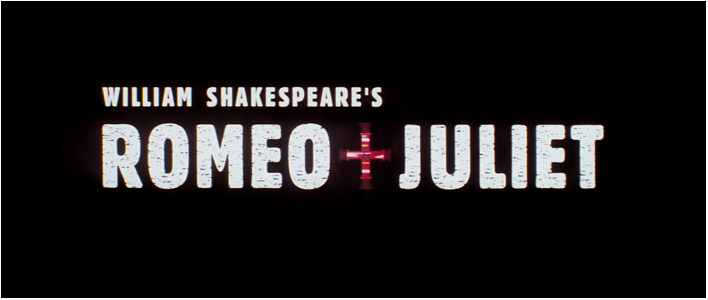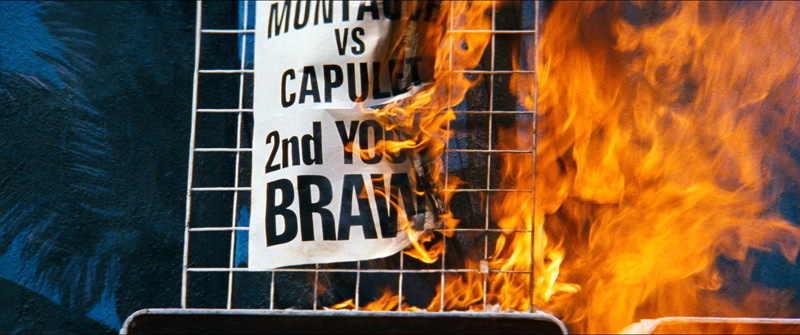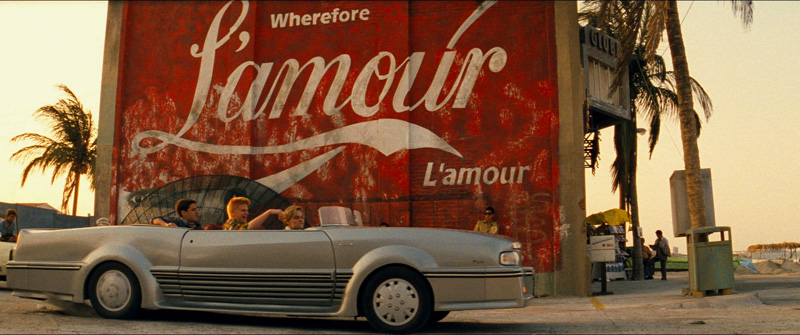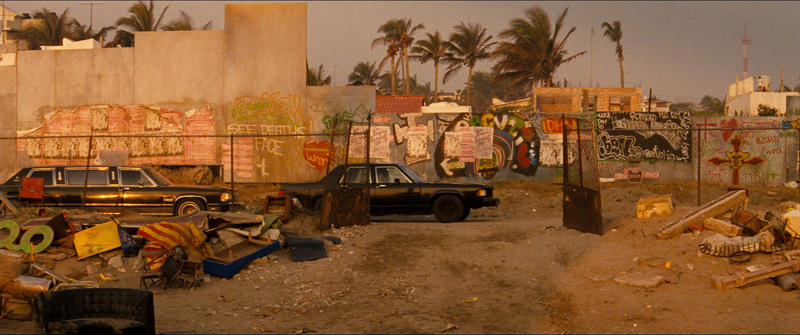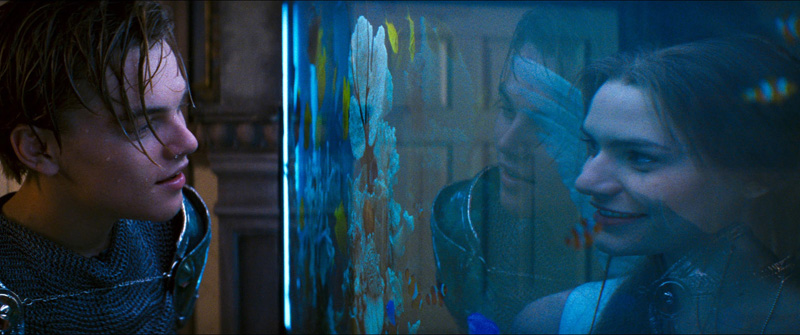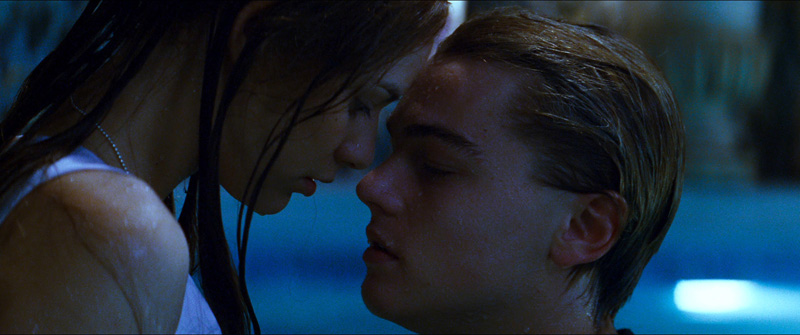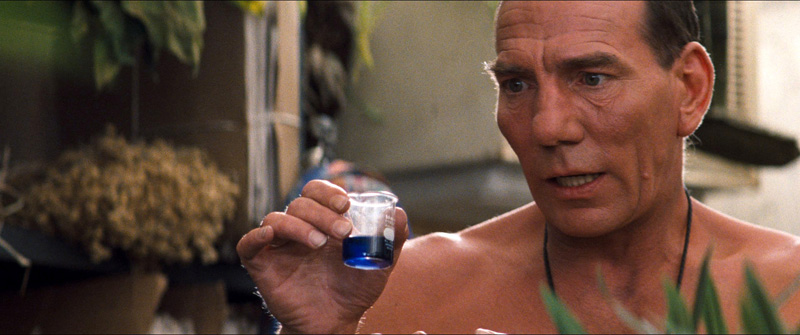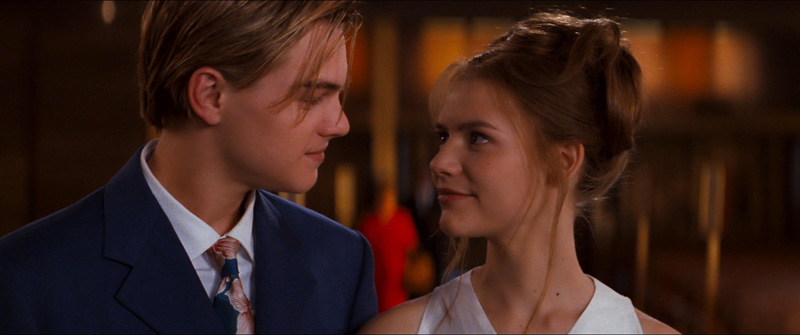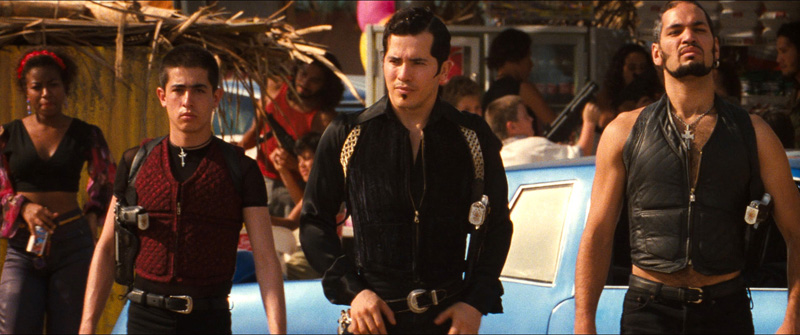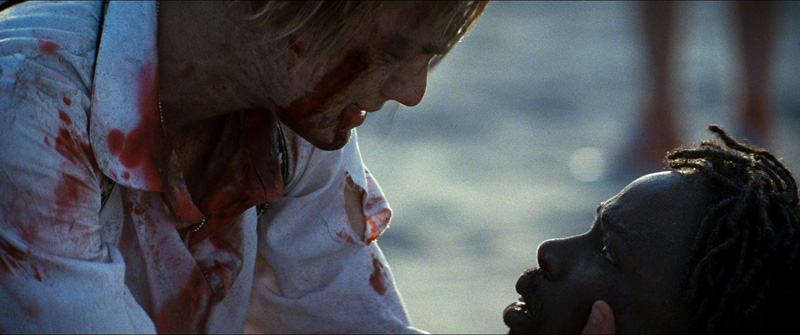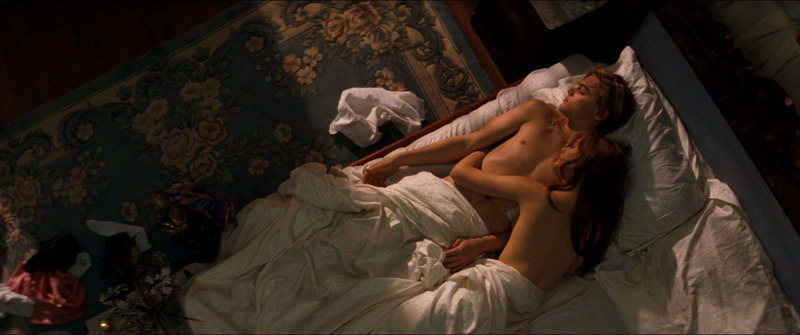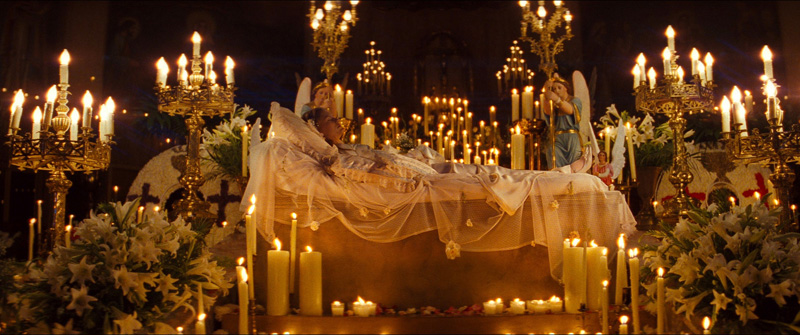Review by Leonard Norwitz
Production:
Theatrical: Bazmark Pty Ltd. (Australia)
Blu-ray: 20th Century Fox Home Entertainment
Disc:
Region: 'A' (B+C untested)
Runtime: 2:00:10
Disc Size: 44,733,473,238 bytes
Feature Size: 27,049,334,784 bytes
Video Bitrate: 20.46 Mbps
Chapters: 29
Case: Amaray Blu-ray Case
Release date: October 19, 2010
Video:
Aspect ratio: 2.40:1
Resolution: 1080P / 23.976 fps
Video codec: MPEG-4 AVC Video
Audio:
English DTS-HD MA 5.1
Spanish 5.1 Dolby Digital
Portuguese Dolby Digital 5.1
French Dolby Digital 2.0 (mono)
English 2.0 Dolby Digital
Subtitles:
English, French, Spanish, Danish, Finnish, Norwegian,
Portuguese, Swedish & none
Extras:
• Shaking Up Shakespeare Picture-in-Picture Mode with Audio
Commentary by Baz Luhrmann, Catherine Martin, Donald M.
McAlpine and Craig Pearce
• Audio Commentary by Baz Luhrmann, Catherine Martin, Donald
M. McAlpine and Craig Pearce
• Uncut Footage from the Bazmark Vault
• Romeo+Juliet: The Music
• Filmmaker and Interview Galleries
• BD-LIVE: Live Lookup
Description: Romeo + Juliet is the second installment of what
Baz Luhrmann calls his Red Curtain trilogy. This film,
together with Strictly Ballroom (1992) and
Moulin Rouge!
(2001) celebrate, in turn: dance, word, and song in what Baz
calls “heightened cinema.” Indeed, there is nothing subtle
about his movies. If you can stand the pressure and the
demand, he sucks you in and splashes you with color,
movement and music, comedy, pathos and ecstasy, romance and
division. In the case of Romeo + Juliet these elements are
given a violent boost. Baz’s Red Curtain movies are love
stories – you may have noticed the big “L’Amour” sign placed
prominently in these films and for his stage version of “La Boheme.” Baz’s textures may be complex, but his stories
aren’t. Repeated viewings are not likely to reveal new
truths or delicate shadings of character or story, but they
will tell you more about how he does what he does and how he
makes you feel the way you do from one moment to the next. I
have found more to enjoy and to love with each viewing, much
more in the case of Romeo, about which I was lukewarm on my
first encounters.
The Film:
7
I can’t say where it all started, possibly with Max
Reinhardt’s 1935 Midsummer Night’s Dream, but the idea that
the cinema held non-traditional possibilities for creative
production certainly felt a resurgence for a spell a decade
or so ago: Richard Loncraine’s Richard III (1995), Kenneth Branagh’s
Hamlet (1996), Julie Taymor’s Titus (1999),
Michael Almereyda’s Hamlet (2000), are among the more
successful adaptations of the plays of the Bard of
Stratford-upon-Avon into more contemporary settings.
Released eight weeks before Branagh’s Hamlet, Baz Lurmann
translated into a dazzling, frantic, violent contemporary
milieu the most tried and true of great love tragedies:
Romeo and Juliet that Baz retitled, presumptuously, “William
Shakespeare’s Romeo + Juliet.”
In 1968 Franco Zeffirelli made a big deal of casting young
unknowns Leonard Whiting (18) and Olivia Hussey (15) in the
parts of the lovers, reminding audiences that Shakespeare’s
play indicated Juliet be not yet 14 and Romeo hardly much
older (“Upon whose tender chin, as yet, no manlike beard
there grew, whose beauty and whose shape so far the rest did
stain"), though surely none of Shakespeare’s actors were
that age and, in any case, none were female. Luhrmann took a
somewhat different path, casting two rising young actors
who, unlike Whiting and Hussey, who not only speak
Elizabethan English, they convey meaning even if we don’t
understand all the words. Danes and DiCaprio are both
American and neither can make coincident word and meaning –
at least not very often. But perhaps they don’t have to.
Luhrmann may be counting on an audience familiar enough with
the text that we can superimpose meaning while he is free to
create the pop gangster culture in which his movie lives.
Leonardo DiCaprio, with This Boy’s Life, Who’s Eating
Gilbert Grape? and The Quick and the Dead behind him, was
already 21, but looks to my eye even younger than Whiting.
The wide-eyed Claire Danes was, at 17, fresh from a raging
success in her debut TV series, “My So-Called Life.” The
rest of the cast is not only older, but more comfortable
with the language, something that Leonardo has a hit and
miss relationship with, mostly miss. Miss Danes may not get
the language right, but she is a natural, if a little dreamy
Juliet. In his scenes with her, Leonardo is more centered
than anywhere else in the movie – save perhaps in the
aftermath of the duel between Tybalt and Mercutio. I have
always said that Leonardo, once he left adolescence, is very
difficult to cast. For all his beauty, he strikes me as
asexual. That said, despite Titanic, The Beach, The Aviator, Romeo + Juliet would remain perhaps his most convincing
rendering of a sexual being thus far.
As for the rest of the cast, they are giddy and earnest
perfection: John Leguizamo, menacing as a psychopathic
Tybalt; Harold Perrineau, mercurial as Romeo’s best friend;
Pete Postlethwaite, as the good Friar, speaking closer to
iambic pentameter that anyone else in the cast; Miriam
Margolyes, as Juliet’s loyal and voyeuristic nurse; Paul
Sorvino and a more or less mute Brian Dennehy as mob dons
Capulet and Montague, each with a very different approach to
their work; and Paul Rudd, a pretty and contented rival,
who, fittingly, looks more like he’s pledging a fraternity
than suing for Juliet’s hand.

To digress for a moment, my early experiences with this film
were not particularly positive. I liked the leads so little
and found Baz’s rendering of time and place so jarring that
I couldn’t let myself go with the flow. Two events, however,
conspired to alter my thinking and my feeling about the
movie. The first was the continued spate of contemporary
film configurations of Shakespeare (along with my favorite
film adaptation of the play, Shakespeare in Love), and my
discovery of Shakespeare Santa Cruz in 1997. Shakespeare
Santa Cruz is noted for their creative productions, of which
I’ve seen twenty since, at least half stretched the
boundaries of time and place, sometimes in several
directions in the same play. Shakespeare Santa Cruz, plus
the aforementioned film adaptations, opened up a much wider
appreciation of possibilities than were available to me when
I first saw Baz’s movie. Within just a few minutes watching
the film last night on Blu-ray I had completely accepted and
understood what Baz was up to. . . which brings me back to
our young stars.
It is in a way fitting that Leonardo and Claire operate in
this movie like there isn’t anyone else in it. Romeo and
Juliet are very young and completely besot with Love. As a
couple they take note of their friends and families only so
far as how to avoid detection – but even there, they flirt
with the disaster of apprehension. They act despite Juliet’s
words of caution. If only their speech were not so much of a
different style than everyone else’s. It’s not like the rest
of the cast is in tune with the stage rhythms we associate
with Shakespeare, but that the other actors exude a
confidence in the language such that we believe they believe
they know what they are talking about. Claire, less so.
Leonardo, still less.
Unlike the later
Moulin Rouge!, which was filmed entirely on
sound stages, Romeo + Juliet was filmed on locations in Mexico
City, Vera Cruz and California. Production Designer
Catherine Martin built a huge half-destroyed stage at the
beach where Mercutio meets his end and Romeo his fate. It’s
a remarkable set, reminding us that this is a play, after
all, and not reality (not that in Baz’s movies, one ever
really needs reminding.) The scene is one of the film’s two
most riveting. The other is Romeo’s arrival at the church,
entirely lit by hundreds of candles, where Juliet is laid
out, looking more beautiful in “death” than in life. It’s a
devastating moment.
Image:
8/9
For the most part this is an excellent transfer. There is,
however, at least one striking example of blue fringing when
Tybalt leaps through the air. In other respects, and
certainly in comparison to the previous DVDs from 2002 or
2007, it is astounding. Flashes of color and fireworks, a
churchful of candles and its otherwise gray setting, the
gleam of gun barrels come alive as never before on home
video. Occasional bits of dirt present in the DVD are gone.
And what few moments where sharpness or smoothing are suspect
- they
are not troubling.
'Blue fringing'
Audio & Music:
8/8
The new uncompressed DTS-HD MA mix is so much more exciting
than the previous DVD Dolby Digital and standard DTS tracks
that it is tempting to give this new one a higher score than
it deserves. Through no fault of the new mix, however,
dialogue is not always as crisp as it should be, especially
considering the remote elegance of the language. Beyond
this, effects and music is pretty much fantastic – perhaps
nowhere more dynamic than in Capulet’s party. That guy
really knows how to throw a party: everything from raucous
crowds to fireworks to serious funk to a lovely ballad from
Sade. Gunplay, car crashes, ambulance screams, helicopter
whooshes, radio & TV news reports all vie for attention with
the ongoing punchy pop music mix that accompanies most of
the movie and demands the surrounds pay homage
Operations:
3
Once arrived at, the PIP feature works very well. Instead of
relying on talking heads, numerous and fleeting clips form
behind the scenes fly into view on one side of the screen,
then the other, deliberately placed it seems so as to reveal
the movie better. The material chosen supports the
commentary. All of this material is densely packed that it
feels like you’re watching a parallel universe for Baz’s
movie. So much for the good news.
Fox continues and expands their idea of hidden menus,
preferring a clean home page to a useful one. The head-scratcher
du jour is the tab titled “SEARCH.” The purpose of a MENU
serves both TABLE OF CONTENTS and SEARCH/FIND functions. It
is therefore redundant at best to include an additional
SEARCH tab in the MENU. Traditionally, thoughtfully, a video
menu is divided into PLAY, SET-UP (or
AUDIO/SUBTITLES/LANGUAGES), CHAPTERS (or SCENES), BONUS (or
EXTRA FEATURES). But when you click on Fox’s SEARCH tab a
new tab comes up titled “SCENES” that needs to be clicked on
in order for you to access said scenes. There are no other
tabs under the SEARCH tab.
It gets worse: Fox divides the movie into 29 chapters - a
sensible number. However the SCENES toolbar displays only
the thumbnail for the scene you’re in at the moment plus a
time line, which would be helpful except that there are no
other visible thumbnails for other scenes, nor can you get
to them without clicking through them one at a time! The
same heartless attitude apples to the Extra Features tab:
you can’t know what’s there until you’ve opened each window
and sub-window. I can’t believe that the people who devised
this menu have ever actually used it in the real world. (By
the way, the same unfriendly approach to Menu design applies
to Fox’s simultaneously released Moulin Rouge!)

Extras:
8
Most, but not all of the extra features found on the “Music”
and “Special” DVD editions appear here. I think the only
segment of value missing is Baz & Craig’s commentary from
the “Music Edition” though some of that content is addressed
in the new PIP commentary (the same as was on the “Special
Edition” DVD.) Baz Luhrmann, Catherine Martin, Craig Pierce,
and Donald McAlpine – the same group that provide comments
on the Moulin Rouge! commentary track. Here they discuss the
Capulet party, the church used for Juliet’s funeral, the
guns (instead of swords), locations, effects, casting and
many other aspects of production.
There’s an “Interview Gallery in HD with actors Leonardo,
Danes and Leguizamo, plus production designer Catherine
Martin, writer Craig Pearce, editor Jill Bilcock,
choreographer John O’Connell, and costume designer Kym
Barrett. Also a half-hour’s worth of behind-the-scenes clips
and comments by Baz for his Director’s Gallery. Similarly,
DP Donald M. McAlpine gets six minutes to enlighten us about
five of his more interesting scenes. But these are all
fairly small potatoes compared to the section titled: The
Music which includes a fascinating 50-minute documentary in
HD about the importance of the music soundtrack from
marketing and aesthetic points of view. There are also
shorter segments under the heading “Everybody’s Free”
brought over from the “Music Edition” DVD.
Bottom line:
8
Even more than Baz’s
Moulin Rouge!
I should think, the
reaction to Romeo + Juliet from critics and public alike has
been sharply divided. I started out more in the Roger
Ebert/Mick LaSalle camp, not very friendly reviews to be
sure, but have since enjoyed pleasures and understandings
heretofore out of my reach. I wouldn’t go so far as to say,
as some critics do, that I’ve discovered “insights” with
repeated viewings, but I have definitely moved from a
restless uncomfortable state to one of amused delights
alternating with serious intensities. I’m not yet convinced
that the entire film, performances and all, works as a
piece, but I can get behind a recommendation – especially
for the Blu-ray with its much improved image and audio. I
should add that the soundtrack for Romeo + Juliet made heaps
of money for the producers and for Capitol Records. It
features the likes of Garbage, Butthole Surfers and
Radiohead – the names kind of tell the story, do they not!
Wikipedia notes that it was the second highest selling album
in Australia in 1997 and went Platinum five times.
Leonard Norwitz
October 27th, 2010
![]()
![]()

![]()
![]()
![]()
![]()

![]()
![]()


